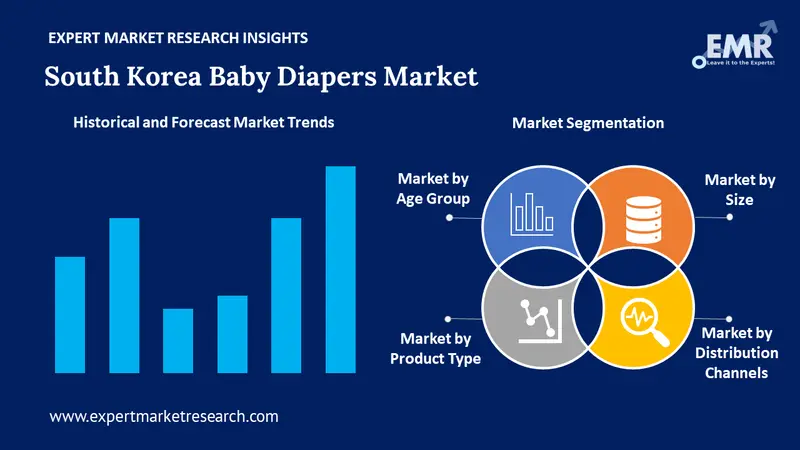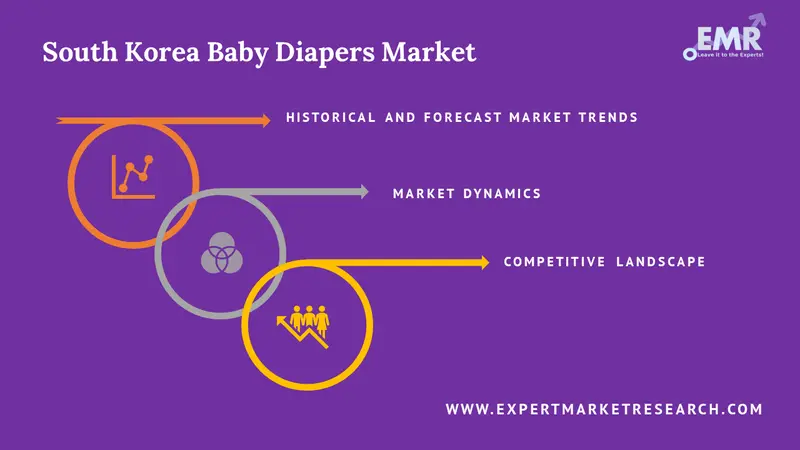
Consumer Insights
Uncover trends and behaviors shaping consumer choices today
Procurement Insights
Optimize your sourcing strategy with key market data
Industry Stats
Stay ahead with the latest trends and market analysis.
The South Korea baby diapers market size reached a value of more than USD 385.99 Million in 2025. The South Korea baby diaper industry is expected to grow at a CAGR of 4.20% between 2026 and 2035, reaching a value of USD 582.44 Million by 2035.
Base Year
Historical Period
Forecast Period
Compound Annual Growth Rate
4.2%
Value in USD Million
2026-2035
*this image is indicative*
A baby diaper, a sort of underwear or nappy that is tied around the bottom and between the legs of a baby, enables the user to defecate or pee without using a toilet by absorbing or retaining waste materials to prevent the soiling of outer garments or the surrounding area.
Lumi is an all-in-one connected system from Pampers that comprises two diaper activity sensors, a Logitech camera that can be used as a Wi-Fi baby monitor, and an app that connects it all. It comes after Huggies Korea's acceptance of the Monit smart diaper sensor. Based on Internet of Things (IoT) technology, the product is called MONIT X Huggies Smart Baby Monitor. The IoT sensor may be quickly and non-contactly affixed to the diaper's exterior surface. In order to replace the diaper when it needs to be, it accurately and instantly signals the presence of faeces and urine to the connected smartphone. The continuous R&D in the industry is being propelled by the rising consumer demand for advanced diapers in the country. The growth of the South Korea baby diapers market is also augmenting as working parents have a hectic work schedule whether they work from home or the office. Hence, smart diaper monitors come in handy for parents as they can easily track the hygiene status of their baby.
The COVID-19 pandemic has affected consumer habits, lifestyles, and the way societies operate. This is demonstrated by the market for disposable and environmentally friendly baby diapers, where repeated temporary lockdowns compelled consumers to switch from disposable to cloth diapers. The market for disposable and sustainable baby diapers is seeing growth opportunities in the South Korean market as a result of public awareness regarding the harm that disposable diapers do to the environment. Several parents who are concerned about the environment and are fashion-forward drawn to the reusable, fashionable, and organic cloth or bamboo diapers available in the market.
Brand awareness development is crucial for any brand to grow and maintain its hold in the market. Therefore, providing consumers with clear information on the benefits of a certain product, including how it will solve their issues and concerns to enhance their quality of living. Firms carefully choose how to market their goods in order to set them apart from their competitors. It is also essential that it can be easily purchased on online and offline distribution channels. The best-laid advertising plans can be derailed by poor distribution. The most crucial thing is that a baby diaper should live up to and beyond consumer expectations. The main drivers of the rapid expansion of online commerce are the quick uptake of smartphones, cost-effective and easy technology access and the ease of purchasing from anywhere, at any time.
The EMR’s report titled “South Korea Baby Diaper Market Report and Forecast 2026-2035" offers a detailed analysis of the market based on the following segments:
Market Breakup by Age Group
Market Breakup by Size
Market Breakup by Product Type
Market Breakup by Distribution Channels

Read more about this report - REQUEST FREE SAMPLE COPY IN PDF
A newborn infant typically wears 8 to 9 diapers every day for the first year, which is 3100 pieces. This amount reduces as children get older, and by the second year, it is only 5 to 6 diapers every day, or around 1950 pieces per year. Diapers are worn by babies until they are 3–4 years old. The infant and young toddler segments are anticipated to experience the most major growth, followed by toddlers and children above 2 years, and factors such as disposable income and easy access to a variety of brands are propelling the baby diaper market's growth.
The demand for infant diaper goods has been considerably influenced by the fast-paced way of life. Customers' growing preference for alternative types of diaper products that are sustainable while also being longer lasting and more comfortable for the baby is also driving up demand for baby diapers. The size segment has small and extra small (X and XS), medium (M), large (L), and extra large (XL) diapers in the market, and all are expected to grow during the forecast period.
Smart diapers relieve stress for parents by requiring fewer diaper changes than conventional diapers. Due to this potential expansion, major firms have increased their spending on product research and innovation in order to achieve a competitive edge. The big companies have made the most of media advertising to promote disposable baby diapers across South Korea. However, awareness regarding the environment and qualities such as being rash-free and breathable is also contributing to the growth of the cloth diaper segment. Baby diaper demand in South Korea will continue to rise as a result of rapid urbanisation and an increase in the proportion of contemporary nuclear households with both parents employed.
The online segment's growth is being fueled by the majority of companies' items being sold through online retailers. The South Korea baby diaper industry has experienced tremendous growth in e-commerce, with businesses building shopping applications and websites to improve customer awareness of their brands. Other segments, especially supermarkets/hypermarkets, and convenience stores, will experience substantial growth due to the availability of various brands and sizes under one roof.

Read more about this report - REQUEST FREE SAMPLE COPY IN PDF
The comprehensive EMR report provides an in-depth assessment of the market based on the Porter's five forces model along with giving a SWOT analysis. The report gives a detailed analysis of the following key players in the South Korea baby diapers market, covering their competitive landscape and latest developments like mergers, acquisitions, investments and expansion plans.
Kimberly Clark Corporation- An American global personal care company called Kimberly-Clark Corporation mostly manufactures consumer goods made of paper. The business produces surgical and medical devices in addition to sanitary paper goods. Scott, Kleenex facial tissues, Cottonelle, Kotex feminine hygiene products, Andrex toilet paper, Wypall utility wipes, Huggies disposable diapers, KimWipes scientific cleaning wipes, and baby wipes are all trademarks of Kimberly-Clark. It was established in 1872 in Wisconsin, United States of America.
Unicharm Corporation- In Japan and abroad, Unicharm Corporation manufactures and sells items for women's health, cosmetics, home goods, and animal care. Disposable diapers and baby wipes are among the baby care items it sells under the MamyPoko, Oyasumiman, Moony, and Torepanman brands. The business also sells disposable diapers, faeces cleanup sheets, system toilets, and pet diets within the category of pet care items. Additionally, it produces and sells industrial materials, food packaging materials, etc. Tokyo, Japan serves as the company's headquarters. It was founded in 1941.
*Please note that this is only a partial list; the complete list of key players is available in the full report. Additionally, the list of key players can be customized to better suit your needs.*
Other key players are KleanNara, The Procter & Gamble Company among others.




*While we strive to always give you current and accurate information, the numbers depicted on the website are indicative and may differ from the actual numbers in the main report. At Expert Market Research, we aim to bring you the latest insights and trends in the market. Using our analyses and forecasts, stakeholders can understand the market dynamics, navigate challenges, and capitalize on opportunities to make data-driven strategic decisions.*
Get in touch with us for a customized solution tailored to your unique requirements and save upto 35%!
In 2025, the South Korea baby diaper market attained a value of nearly USD 385.99 Million.
The market is projected to grow at a CAGR of 4.20% between 2026 and 2035.
The market is estimated to witness a healthy growth in the forecast period of 2026-2035 to reach USD 582.44 Million by 2035.
The growing disposable income, increasing awareness regarding eco-friendly alternatives, improved and fast functioning of online stores, lifestyle shift after the COVID-19 pandemic are the major drivers in the industry.
The surge of smart baby diapers and research and development are the key trends of South Korea baby diaper market.
The dominant types of baby diapers in the industry are disposable diapers and cloth diapers.
The leading distribution channels in the market are supermarkets/hypermarkets, convenience stores, pharmacies, and online, among others.
The major players in the industry are Unicharm Corporation, Kimberly-Clark Corporation, KleanNara, and The Procter & Gamble Company, among others.
Explore our key highlights of the report and gain a concise overview of key findings, trends, and actionable insights that will empower your strategic decisions.
| REPORT FEATURES | DETAILS |
| Base Year | 2025 |
| Historical Period | 2019-2025 |
| Forecast Period | 2026-2035 |
| Scope of the Report |
Historical and Forecast Trends, Industry Drivers and Constraints, Historical and Forecast Market Analysis by Segment:
|
| Breakup by Age Group |
|
| Breakup by Size |
|
| Breakup by Product Type |
|
| Breakup by Distribution Channels |
|
| Market Dynamics |
|
| Competitive Landscape |
|
| Companies Covered |
|
Datasheet
One User
USD 2,499
USD 2,249
tax inclusive*
Single User License
One User
USD 3,999
USD 3,599
tax inclusive*
Five User License
Five User
USD 4,999
USD 4,249
tax inclusive*
Corporate License
Unlimited Users
USD 5,999
USD 5,099
tax inclusive*
*Please note that the prices mentioned below are starting prices for each bundle type. Kindly contact our team for further details.*
Flash Bundle
Small Business Bundle
Growth Bundle
Enterprise Bundle
*Please note that the prices mentioned below are starting prices for each bundle type. Kindly contact our team for further details.*
Flash Bundle
Number of Reports: 3
20%
tax inclusive*
Small Business Bundle
Number of Reports: 5
25%
tax inclusive*
Growth Bundle
Number of Reports: 8
30%
tax inclusive*
Enterprise Bundle
Number of Reports: 10
35%
tax inclusive*
How To Order

Select License Type
Choose the right license for your needs and access rights.

Click on ‘Buy Now’
Add the report to your cart with one click and proceed to register.

Select Mode of Payment
Choose a payment option for a secure checkout. You will be redirected accordingly.
Gain insights to stay ahead and seize opportunities.

Get insights & trends for a competitive edge.

Track prices with detailed trend reports.

Analyse trade data for supply chain insights.

Leverage cost reports for smart savings

Enhance supply chain with partnerships.

Connect For More Information
Our expert team of analysts will offer full support and resolve any queries regarding the report, before and after the purchase.
Our expert team of analysts will offer full support and resolve any queries regarding the report, before and after the purchase.
We employ meticulous research methods, blending advanced analytics and expert insights to deliver accurate, actionable industry intelligence, staying ahead of competitors.
Our skilled analysts offer unparalleled competitive advantage with detailed insights on current and emerging markets, ensuring your strategic edge.
We offer an in-depth yet simplified presentation of industry insights and analysis to meet your specific requirements effectively.
Share